Media
Summary
Scientists have found a method to use gravitational waves for understanding the early universe. Plus, an exoplanet with no atmosphere, spiders in space (CW), citizen science, and X-ray bubbles in the Milky Way. And the first of our new weekly segment: This Week in Sky Watching.
Transcript
This is the Daily Space for today, Thursday, December 10, 2020. I am your host, Dr. Pamela Gay.
And I am your host, Beth Johnson.
And we are here to put science in your brain.
One of the things about being a scientist is you have to accept that periodically throughout your career, things you learned as “This is certain” sometimes get flipped to, “Oh, that was completely wrong.”
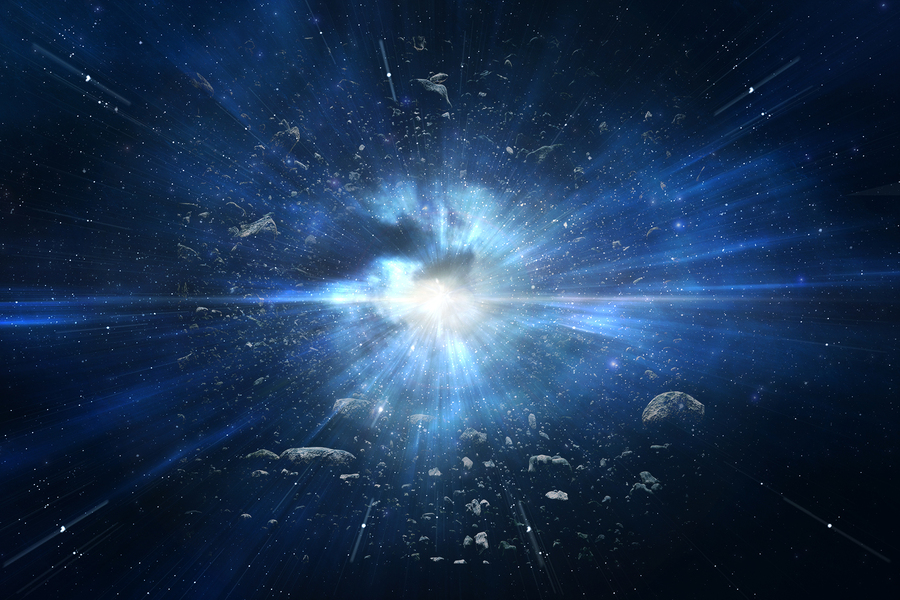
Sometimes it’s just an assumption: back in 1998, we learned that our assumption that the constant lambda, which we’d happily set to zero for most of a century, was actually a real number thanks to the overwhelming amount of dark energy that no one expected would be populating the universe.
Sometimes it’s the immutable nature of an isolated particle that is only thought to change by decay processes. No, particles can change wildly, or at least, as we learned in 2001, neutrinos can change wildly as they oscillate between different flavors.
Today, I find myself confronted with a new “We never thought we could” kind of moment.
For the past many years I have sworn up and down that we would never be able to measure anything that happened in the universe prior to the formation of the cosmic microwave background (CMB). That wall of light came into existence about 400,000 years after the Big Bang and was created in the moment the universe went from a soup of free electrons and fully ionized atomic nuclei to a neutral gas of atoms, with every atom emitting light as it glommed onto electrons. Prior to that moment, our universe was opaque, and there is no observational way to see what happened. We can only see the shadows of past physics in the distribution of that released light.
In 2015, however, we developed a new way to explore our sky: for the first time our equipment became sensitive enough, and our software good enough, to allow the LIGO and Virgo systems to detect gravitational waves. These oscillations in space-time come in many kinds and sizes that are driven by all kinds of events. So far, we’ve only been able to detect the mergers of neutron stars and small to intermediate-sized black holes, but this is a technological limitation rather than a physics limitation.
In a new paper in Physical Review Letters, researchers led by graduate student Sylvia Biscoveanu, have developed a potential technique for separating out sounds of nearby gravitational wave sources and sort through the background noise to detect those gravitational waves that originated in the early universe. If this can be done, it will allow us to get data from a time before the formation of the CMB.
According to Biscoveanu: If the strength of the primordial signal is within the range of what next-generation detectors can detect, which it might be, then it would be a matter of more or less just turning the crank on the data, using this method we’ve developed. These primordial gravitational waves can then tell us about processes in the early universe that are otherwise impossible to probe.
This isn’t easy, and so far this team is only working with simulated data. But their technique is recovering their simulated background of gravitational waves, and this is no easy task. As Biscoveanu explains: The analogy I like to make is, if you’re at a rock concert, the primordial background is like the hum of the lights on stage, and the astrophysical foreground is like all the conversations of all the people around you. You can subtract out the individual conversations up to a certain distance, but then the ones that are really far away or really faint are still happening, but you can’t distinguish them. When you go to measure how loud the stage lights are humming, you’ll get this contamination from these extra conversations that you can’t get rid of because you can’t actually tease them out.
So, it turns out, we may be able to sense signals back to the beginning of the universe. We just won’t be able to see them. Light isn’t the answer for exploring the early universe, but gravity might just get us there.
The study of exoplanets is another great way to find out everything you knew about science, in particular planetary formation and evolution, was wrong. When your sample set includes a solar system of one, you begin to think, “Other solar systems must be similar.” And then you put up a telescope or two, find thousands of exoplanets, and discover, “Huh. It’s wilder out there than we imagined.”
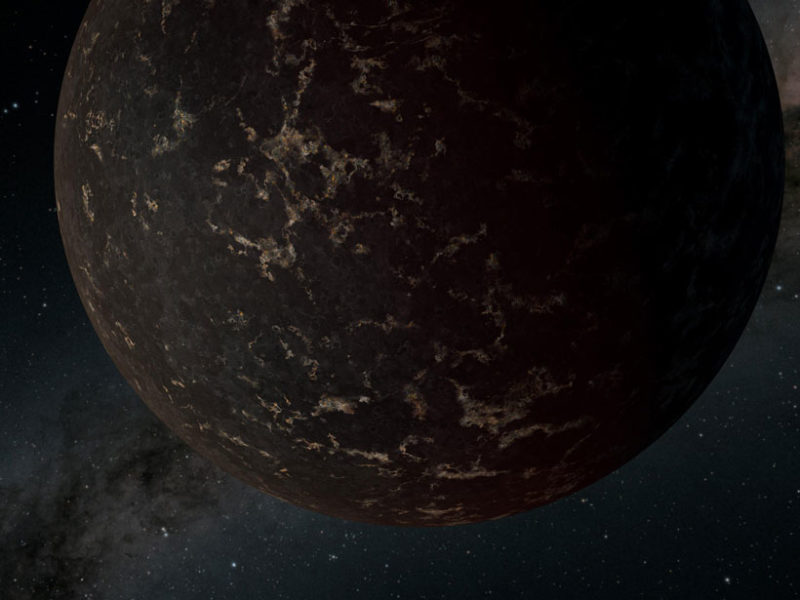
Such is the case with exoplanet LHS 3844b, a small, rocky planet, slightly bigger than Earth. It’s tidally locked, like Mercury. It has no atmosphere, like Mercury. And then everything goes sideways. LHS 3844b always has the same side facing its star, so the planet’s surface can reach 770°C on the dayside and near absolute zero on the nightside. Not only that but in research presented this week at AGU’s Fall Meeting, researchers explained how they used those surface temperatures to find that the planet’s mantle could flow in a half-and-half pattern. Basically, it flows upward on one side and downward on the other.
They used simplified models to test several convection scenarios, varying the strength of the lithosphere material between very weak and strong but still pliable. Lead researcher Tobias Meier goes on to explain: We also vary the heating mode wherein one set of models we have basal heating, which means that all the heat that we generate comes from within the core. And in a second set of models, we also add internal heating to that, which means that we generate heat within the mantle that could come, for example, from the decay of radioactive elements.
They found that three of the models produced the half-and-half hemispheric scenario, while only one model – with stronger material and internal heating – produced Earth’s version of a mantle. So while LHS 3844b is the first exoplanet we’ve found without an atmosphere, it’s also the first one we’ve modeled with this mantle convection pattern.
Computational geodynamicist Rene Gassmoeller further explains: Since these conditions are very strict, it is unlikely any planets in our solar system fulfilled them at any point in the history of the solar system. Mars is too far out. Earth and Venus have atmospheres and are not tidally locked. Mercury is tidally locked, but not in a synchronous rotation, so all surface locations still experience day and night.
As always, we have found more pieces to the solar system formation puzzle. We’re not even close to done, yet.
And now, a content warning. The next story contains spiders, and our graphic is related. You have been warned.
I for one like spiders. I’m one of those people will happily pill out a macro lens to try and capture a spider in its web, or wait for the sun to hit just the right angle to catch dew on a web. I kind of adore orb spiders, I am here for any and all things spider web related.
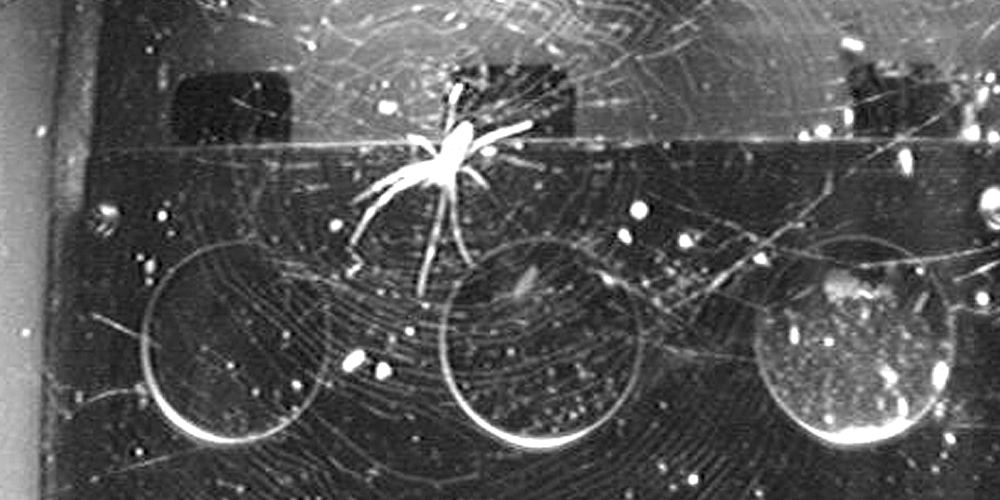
As some of you may remember, back during the shuttle program, some students had a cool project to study how spiders form webs in zero-g selected to fly. This particular experiment did not go well and was, in fact, the kind of spectacular failure where things go so wrong you have to laugh. I’m going to simply quote from a summary from the University of Basel.
Two specimens from different spider species flew to the International Space Station (ISS) as “arachnauts,” one (Metepeira labyrinthea) as the lead and the other (Larinioides patagiatus) as a reserve in case the first didn’t survive.
The reserve spider managed to break out of its storage chamber and into the main chamber. The chamber couldn’t be opened for safety reasons, so the extra spider could not be recaptured. The two spiders spun somewhat muddled webs, getting in each other’s way.
And if that were not enough, the flies included as food reproduced more quickly than expected. Over time, their larvae crawled out of the breeding container on the floor of the case into the experimental chamber, and after two weeks covered large parts of the front window. After a month, the spiders could no longer be seen behind all the fly larvae.
Needless to say, there wasn’t a lot learned from this experiment, beyond flies thrive in zero-g and spiders are always escape artists.
This failed experiment left researcher Paula Cushing wondering what could have been, and in 2011, she was able to work with Dr. Samuel Zschokke to do a better experiment. Their results are now published in the journal The Science of Nature.
Their intention was to launch two identical spiders in identical habitats into space, and have two control spiders on Earth. While they meant to have four female spiders, it turned out that two of their spiders were actually male-presenting once they grew large enough to be easily differentiated, but one of those boys was on the Earth and the other was in space, so the research could proceed.
Here on Earth, spiders are known to build their webs in all kinds of lighting and lack of lighting conditions. In general, those webs have the highest density area – that bulls-eye of concentric rings we call the center – actually off-center and located higher up in the web. The spiders typically hang out on that nexus with their head facing downward as they wait for prey to get stuck.
Because spiders build identical webs with and without light, it was assumed light played no role in web construction.
But, you know what they say about assumptions…
In the 2011 spiders-in-space experiment, researchers studied webs the spiders spun both with and without light, and watched how the spiders oriented themselves. Webs woven in darkness turned out to be symmetric, while those built while the habitat was illuminated from the top had the same asymmetric shape as those seen on Earth. Without light, the spiders randomly oriented themselves, but with that light turned on, they hung head down.
It turns out, in the absence of weight, spiders will look to the light for orientation. It’s cool that even arachnids have backup systems for when the pull of the Earth seems to go away.
I would like more of this science, please.
Pardon me while I recover from that one.
Here at CosmoQuest, we love citizen science. We were built on citizen science and community. So I’m always thrilled when I see a story come out where citizen scientists have done well. And this next story even comes from my other home institution, the SETI Institute.
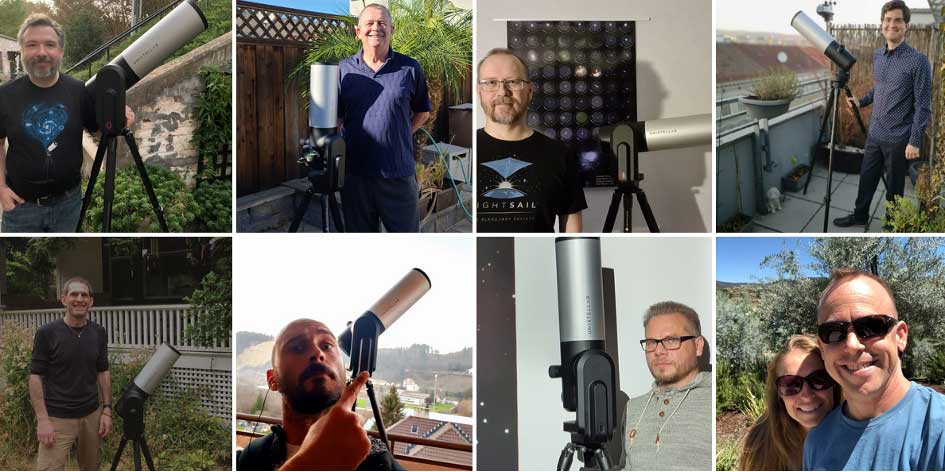
Some of you may have heard about a new company called Unistellar that has produced an all-in-one telescope. The telescope is cool, but what’s even cooler is that its users are automatically part of a global network of astronomers who can perform science with very little warning. Twenty-six of those astronomers recently detected and modeled a near-Earth asteroid (NEA), making them the first planetary defense team of citizen astronomers.
The asteroid in question is 1999 AP10, one of about 20,000 known NEAs. Astronomers from Austria, Cyprus, Finland, France, Switzerland, the United Kingdom, and the United States all turned their eVscopes to observe the asteroid in October and November of this year. The information collected allowed Joseph Durech, from Charles University in Prague, to model the asteroid, making 1999 AP10 only the 69th NEA whose shape we know.
Franck Marchis, senior astronomer at the SETI Institute and Chief Scientific Officer of Unistellar said: The Unistellar network of citizen astronomers accomplished something that professional astronomers have rarely done before. This proves the potential for meaningful Planetary Defense work to be conducted by everyday citizens who share a passion for space. Continuous observations of Near-Earth Asteroids when they are close to Earth are critical to understand them and potentially mitigate their risk to our planet.
Way to go, team. This result isn’t the first from the SETI Institute and Unistellar science partnership, and I doubt it will be the last. You know I’ll keep you all informed of future work.
Today’s science has so far stayed pretty close to home, but for this last news item, we’re going to take a look at the center of our galaxy.
Back in 2010, it was discovered that there are gamma-ray emitting shocks tracing out bubbles blown by our galaxy’s supermassive black hole (SMBH). At some point in the distant past, our SMBH consumed a bunch of who knows what and became temporarily active, and the magnetic fields associated with that activity spewed material out that blew bubbles in the material in the central bulge and beyond.
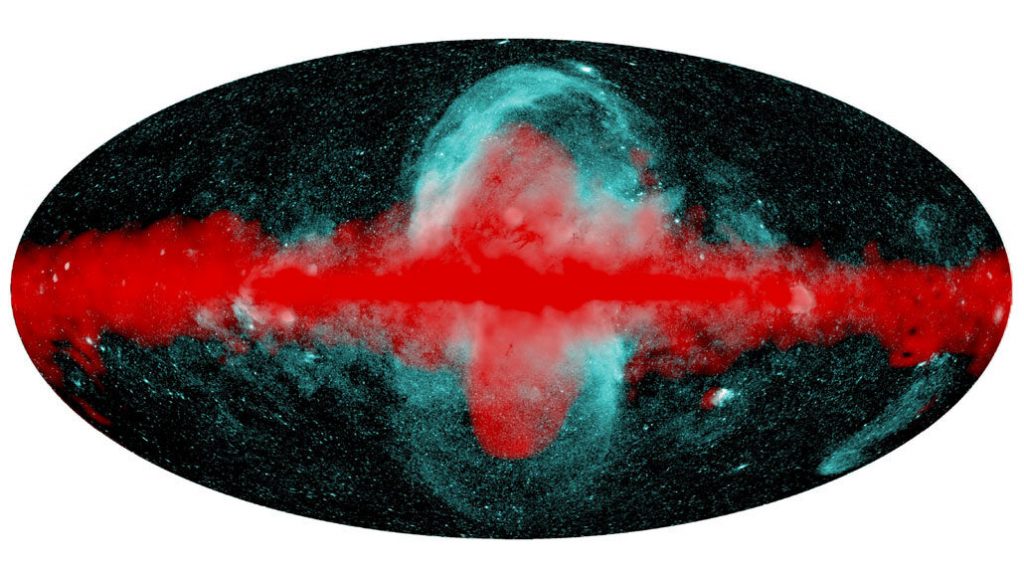
An additional X-ray arc had been previously discovered earlier this year, but only on one side of the galaxy, in the direction we generally think of as up or north. Further observations, however, were able to find a matching feature below the galaxy. These X-ray arcs are symmetric with the gamma-ray bubbles, suggesting the features are connected. This work appears in the journal Nature in a study with lead author P. Predehl.
This is just cool, and the idea that our galaxy has been blowing bubbles is the kind of science we all need in this year that shall not be named.
And now we bring you a new recurring segment here on the Daily Space: This Week in Sky Watching. Every Thursday, we will tell you all about upcoming observational events and encourage you to go outside and look up, weather conditions permitting of course.
First up, we have the peak of the Geminids meteor shower on December 13 and 14. Side benefit, the moon will be new at the time, so if you have fairly dark, cloudless skies, you won’t have to worry about that pesky bright globe getting in your way. The peak of the shower should start on Sunday evening and last much of the night.
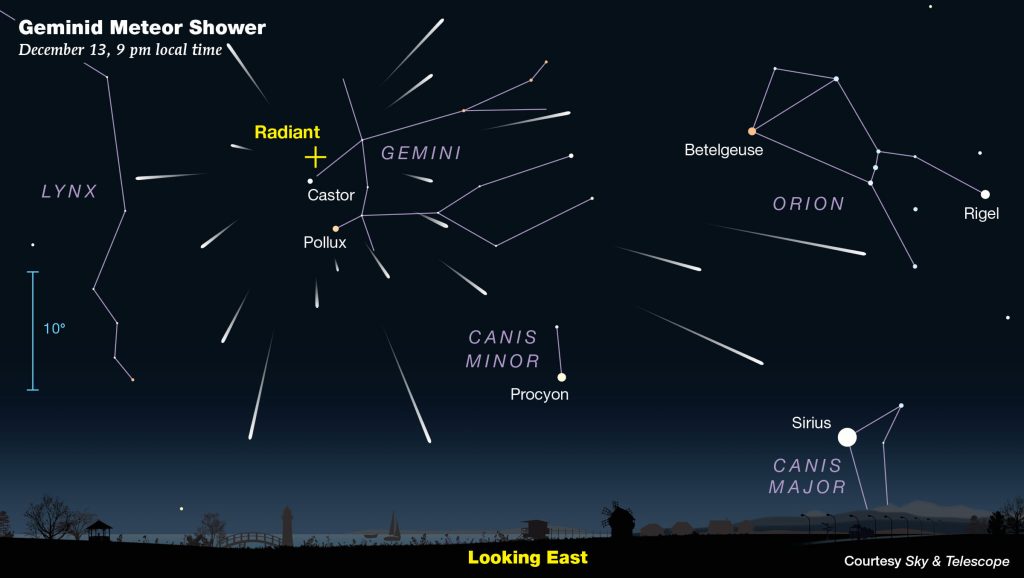
Now for the science. Meteor showers are caused when Earth passes through streams of debris left from orbiting comets. As a comet regularly goes around the Sun, it heats up, and the ice contained within sublimates, which releases small rocks and dust particles all along its path. Those bits and pieces continue to orbit the Sun, and every so often, Earth passes through a section of them. They hit our atmosphere and burn up spectacularly, causing numerous large and small showers throughout the year.
We call the place from where all the meteors of a given shower seem to originate its radiant, and next week’s shower seems to come from the constellation of Gemini, particularly close to the bright star Castor.
As Sky & Telescope explains: For viewers at mid-northern latitudes, the radiant is well above the eastern horizon by around 9 p.m. local time on December 13th. The radiant will stand highest at 2 a.m. local time on December 14th, which is ideal viewing time for those who can stay out late. Even though the peak has already occurred, meteor numbers should increase significantly after midnight, since that’s when Earth plows directly into the meteoroid stream.
Oh, remember how I said comets cause meteor showers? It’s not actually the case with the Geminids. The parent body of this particular display is asteroid 3200 Phaethon, a “rock comet” that has the characteristics of both an asteroid and a comet. Phaethon orbits the Sun every 1.4 years, closer in than any other asteroid, and rather than sublimate any type of ice, it simply sheds dust grains as it gets closer and closer.
So grab your kids or anyone else you’re stuck in the house with, the hot beverage of your choice, some warm blankets and maybe a pillow, kick back under a darkish sky, and keep watch.
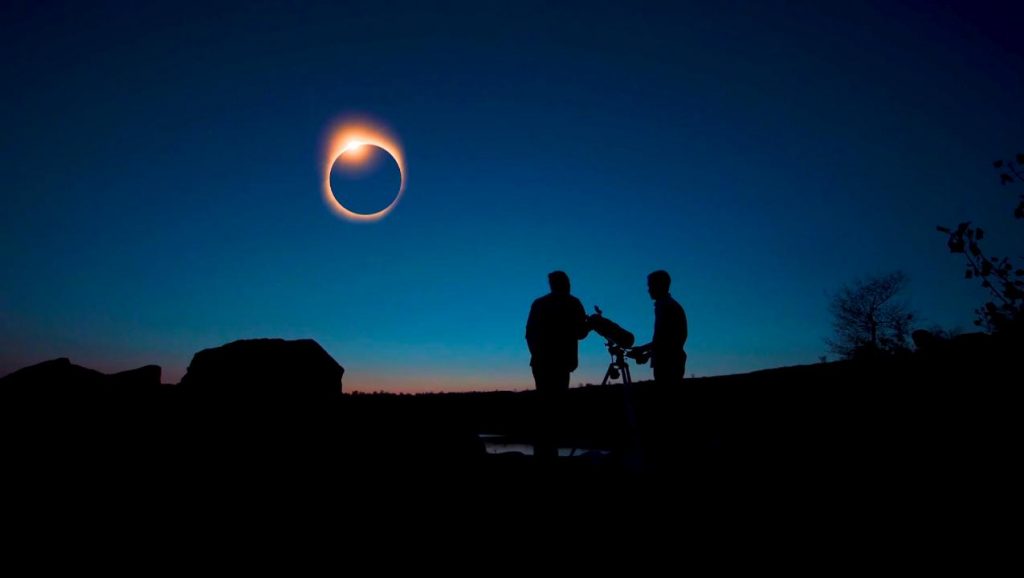
The sky isn’t only dark at night. Sometimes, usually no more than twice a year, the sky can go dark during the day, and that is going to happen next Monday when a total solar eclipse passes over Chile and Argentina. While most tours to experience this event IRL have been canceled, there will still be folks with cameras out there streaming it back for all of us to enjoy on the internet. The Exploratorium, which is known for its eclipse streams, will be hosting coverage starting at 7:30 am Pacific / 10:30 am Eastern on YouTube and Facebook.
While I’m guessing no one watching this will be in a position to view the eclipse face-to-face, there is another fairly rare and awesome thing you may be able to see. Our Sun is currently transitioning from a boring blob of plasma to a spotty mess of magnetic field lines capable of flinging high energy particles at our planet.
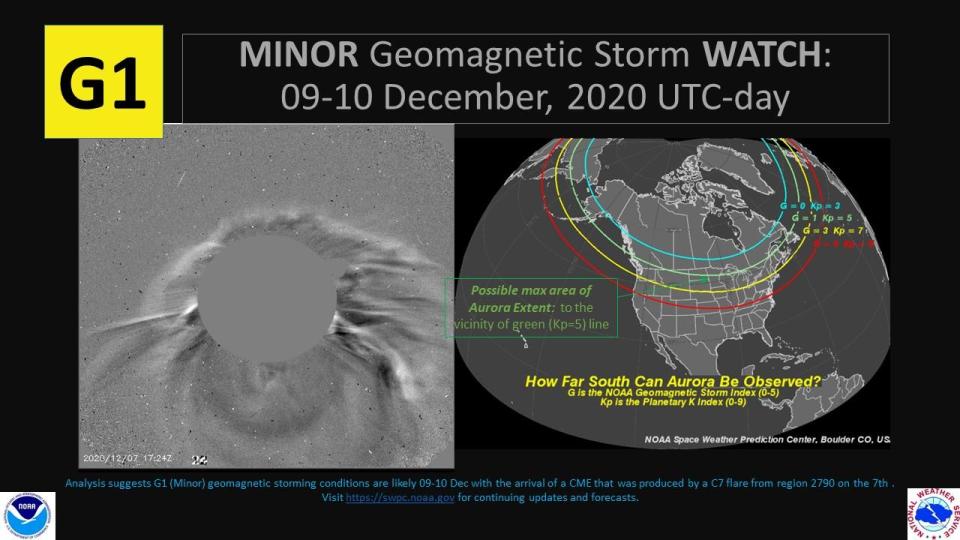
And when it does this, we can be in for a treat in the form of aurorae. NOAA is predicting that aurorae will be visible for most of Canada & the northern United States. It’s unclear if the timing will be right for Europe and northern Russia, China, and Japan.
If you are somewhere that may be able to see this storm, go find someplace dark, look up, and enjoy. This is definitely a “Take the car with the sunroof” kind of event. Also, take stuff to stay warm. It’s cold out there, folks.
Some of you have already started observing our next night-sky event and sharing your photos in our Discord. I’m speaking, of course, about the upcoming conjunction of Jupiter and Saturn, which will be at their closest on December 21. While that event is more than a week away, it’s a good time to start checking in every night and watch them get closer and closer. On December 21, they will appear as one very bright star in the sky.
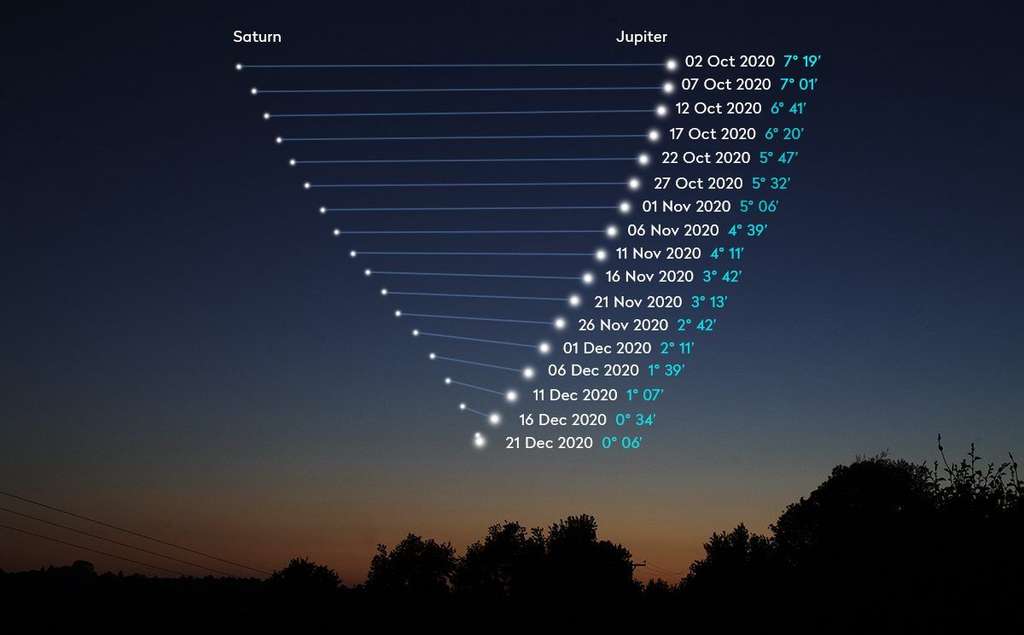
This Jupiter-Saturn conjunction, where the two planets get incredibly close together in the sky (not in their orbits… that would be bad), happens every twenty years or so. But Jupiter and Saturn haven’t been this close in 400 years, and such a close conjunction hasn’t been observable in 800 years. Talk about your rare events.
Astronomer Bob Mizen told Sky at Night Magazine how to plan your observations: You need to be at an observing site that has a nice westward view without trees or buildings blocking the horizon. The planets will be sinking all the time, so time it carefully. The two planets will have sunk in the southwest by around 18:20, but aim to look from 16:30 when the spectacle will become visible while being at its highest in the sky. The ‘great solstice conjunction’ will take place just within the boundaries of the constellation of Capricorn while a 50% illuminated First Quarter Moon shines high in the south.
Unlike meteor watching, all you need for this observation is some clear night sky to the west and access to the horizon. If you take photos, please tag us on social media or share them with us in Discord.
This has been the Daily Space.
Learn More
A technique to sift out the universe’s first gravitational waves
- MIT press release
- “Measuring the Primordial Gravitational-Wave Background in the Presence of Astrophysical Foregrounds,” Sylvia Biscoveanu, Colm Talbot, Eric Thrane, and Rory Smith, 2020 December 9, Physical Review Letters.
Airless Exoplanet’s Mantle Could Flow in Halves
Spiders in space: without gravity, light becomes key to orientation
- University of Basel press release
- “Spiders in space—orb-web-related behaviour in zero gravity,” Samuel Zschokke, Stefanie Countryman & Paula E. Cushing, 2020 December 3, The Science of Nature
Citizen Astronomers Across the Globe Partner for World-Record Research on a Near-Earth Asteroid
Enormous X-ray bubbles balloon from the center of the Milky Way
- Science News article
- “Detection of large-scale X-ray bubbles in the Milky Way halo,” P. Predehl, R. A. Sunyaev, J. Wilms, 2020 December 9, Nature.
Sky Watch: CME aurora, December 9-10
Sky Watch: Geminids meteor shower, December 13-14
Sky Watch: Total solar eclipse, December December 14
Sky Watch: Jupiter-Saturn conjunction, December 21
Credits
Written by Pamela Gay and Beth Johnson
Hosted by Pamela Gay and Beth Johnson
Audio and Video Editing by Ally Pelphrey
Content Editing by Beth Johnson
Intro and Outro music by Kevin MacLeod, https://incompetech.com/music/


 We record most shows live, on Twitch. Follow us today to get alerts when we go live.
We record most shows live, on Twitch. Follow us today to get alerts when we go live.